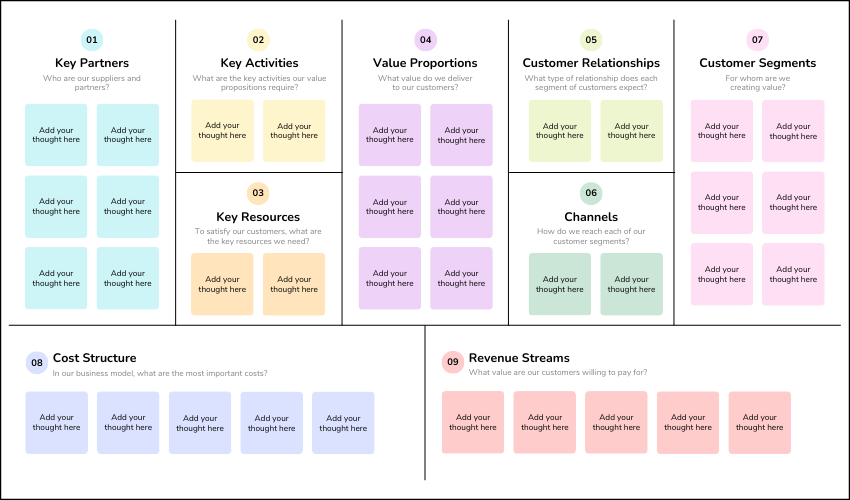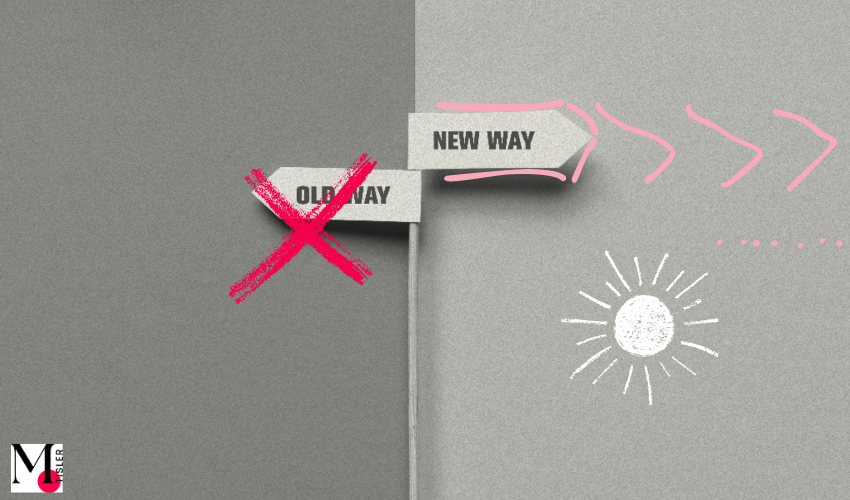Optimize Operations: 47 Practical Continuous Improvement Examples In 2024
Share it
What Are the Best Continuous Improvement Examples?
52% crash from innovation amnesia (source: Nextstudio.org). Avoid that fate.
This AI-powered world demands constant evolution, not “business as usual.” Ditch stagnation and explode your operations with these 47 mind-blowing continuous improvement (CI) examples – from my life as a process geek to industry success stories.
No matter your CI philosophy (Kaizen? Six Sigma? Lean? Total Quality Management? Just-in-Time? I got you!), this is your roadmap to skyrocket reputation, productivity, and profits in 2024.
Join the top 48% – read on and unlock your operations’s hidden potential.
BUSINESS STRATEGY & PLANNING
1.) Business Model Canvas For All
The Business Model Canvas serves as the CORNERSTONE for effective management and continuous improvement. It acts as a visual blueprint, offering an overview of your organization’s key activities, value proposition, and customer relationships, among other things.
Eliciting and sharing this canvas across all leadership levels is CRUCIAL. It ensures everyone is on the same page regarding business intent, goals and the means to attain them.
Plus, it bridges the gap between strategy and execution and promotes a culture of transparency and inclusivity.
As the business landscape evolves, these practices become even more important, setting the stage for substantial GROWTH in 2024 and beyond.
By incorporating such practices, companies create a more unified approach, ensuring everyone is aligned and engaged, working towards the COMMON GOALS defining success.
2.) Order Your Firm in 3 Key Activities
Ah, the lovely world of business structuring.
It’s not about throwing things into bins but optimizing. Think of it as organizing a messy room into three MAIN areas: Management, Core, and Support.
Management activities: The BACKBONE of your operation. They include strategic planning, decision-making, industry specialism and ensuring everything runs like clockwork.
Core activities: This is the HEART of your firm – it focuses on operations directly linked to revenue, such as product development, sales, marketing, and customer service. Your business THRIVES on these.
Support activities: Although not revenue-generating, think of these as the OIL that keeps the machine running. Functions like HR, IT support, and administration are vital. A robust support framework ensures the smooth functioning of both CORE and MANAGEMENT activities.
Understanding these categories can clarify your goals, foster collaboration across teams, and help prioritize investments for a more efficient and continuously improving business environment.
3.) Elicit Your Business Architecture Value Streams
What’s the heartbeat of your firm?
It might just be the value streams, those nifty flowcharts representing how you deliver value to customers and stakeholders.
Essentially, they define why you get out of bed every day and do what you do.
They help pinpoint customer and employee pain points to streamline operations, boost productivity, and enhance the user experience.
This leads to faster service, smoother transactions, and increased loyalty. These are easy to grasp and CLEAR up what needs to be done.
Ultimately, they allow you to IMPROVE operations, innovate, and develop NEW products. It’s not about staying ahead in the rat race but delivering top-notch experiences.
It’s essential.
4.) Elicit Your Key Business Capabilities
You’ve got those value streams lined up, but what’s next? Match them with your key business capabilities.
These are the skills your team needs to make magic for your customers.
You’re painting a vivid picture by mapping these critical capabilities to your value streams. Spot if skills should be kept in-house, set quality standards, and decide on new talent or where to upskill.
Here’s a nugget: these capabilities are your company’s arsenal, setting you apart from the competition. They’re stable, so today’s investment might pay off BIG TIME later.
These insights also provide the groundwork for other strategic documents, helping to pinpoint other areas that require investment or improvement.
Staying ahead isn’t just about trends. Knowing your core capabilities allows you to tackle 2023 with flair.
5.) Excel at Your Core Activities
Core activities are what really make your business stand out from the competition.
When you excel in these areas, it has a HUGE impact on customer satisfaction and can bring joy to both your customers and employees.
But here’s the thing: it’s not just about focusing on core activities.
You also need to pay attention to management and support functions.
These activities provide the strategic direction and oversight that align your core functions with your overall business goals.
6.) Business Strategy Made Visible
Have you ever considered the impact of everyone in your organization truly understanding the business strategy?
Imagine your strategy in SIMPLE LANGUAGE, displayed on large posters around the office, shared on the intranet, and readily accessible to remote workers.
It’s more than just visibility; it’s about fostering a sense of shared purpose. Leaders will find it natural to reiterate and connect daily tasks to this BIGGER PICTURE, making it part of regular conversation.
It’s a game-changer when everyone sees how their individual roles tie into the grand plan.
Alignment, engagement, and a cohesive team working towards a common goal – that’s what making your business strategy visible to all can achieve.
7.) Convey Your Product or Service Value
Think about it this way: Your business isn’t just a merchant selling products or features.
What you offer creates real value for your customers, solving their problems and enhancing their lives.
This value is your business’s lifeblood, and everyone on your team should be crystal clear about it.
Imagine if every employee could articulate this value in their interactions, focusing on how the products or services can truly make a difference.
It’s not just about selling; it’s about connecting with customers on a deeper level.
When this value is communicated clearly and consistently across the organization, it doesn’t just help in problem-solving – it becomes the compass guiding every decision, and action and helps create a culture of continuous improvement.
8.) Do & Share Competitor Analysis
Competitor research isn’t just for your marketing team – it’s everyone’s business. It equips you to navigate the industry landscape successfully. Don’t just use Google Alerts or SEMRush; share these insights with your staff.
This not only sparks innovative ideas but also boosts employee engagement. Transparency fosters a culture of shared responsibility.
A Salesforce report shows that employees who feel heard are 4.6 times more likely to give their best work. So, communicate these market trends, compare them against your customer personas, journey maps, and employee feedback, create conversations, and encourage this empowerment.
Stay ahead of the game, keep your team informed, and watch as they transform this knowledge into powerful business strategies.
Check out this Salesforce State of the Connected Customer Report for more insights on employee empowerment. Competitor research? It’s a win-win scenario!
EMPLOYEE ENGAGEMENT & MANAGEMENT
9.) Coaching for Engaging Presenters
Ever sat through a lifeless presentation from a leader and felt like falling asleep?
It happens, but it doesn’t have to be that way. Your senior leaders and middle managers set the tone for the entire company. When they’re inspiring speakers and presenters, it can totally INSPIRE the workforce.
Think of leaders like Steve Jobs, who had an extraordinary ability to connect with his audience and tell a compelling story. His presentations were sleek, minimalist, and engaging, often leading to standing ovations.
Or consider that Simon Sinek’s “Start With Why” philosophy resonated with countless people because of its insightful observations and clear communication style.
It might seem a bit fluffy, but getting your leaders to be more engaging isn’t just about making speeches more fun. It’s about exciting your teams and getting them pumped about what your company offers and their roles within it.
Training your leaders to present with passion can make a world of difference in your company’s culture. And who knows?
The next ICONIC BUSINESS COMMUNICATOR might be in your boardroom!
10.) Involve Staff in Decision Making
Changes in business can happen SUDDENLY.
That’s why keeping your employees in the loop is essential, not just during planned changes but all the time.
When your team is regularly engaged in decision-making, they’re more prepared and adaptable when unexpected shifts occur.
Whole Foods Market, for example, has implemented a decentralized, team-based structure where employees have a say in various aspects of the company. It’s like nurturing a squad of in-house experts, always ready to face challenges because they’re invested in shaping the company’s path.
This ownership mentality is fostered by practices similar to Amazon’s Leadership Principle, “Ownership,” which encourages employees to think like owners and take initiative to make improvements.
They’ll feel valued, and you’ll benefit from their insights, revealing hidden opportunities or issues that might be missed otherwise.
Companies like SEMCO have demonstrated how involving employees in decisions like working hours and business strategies can create a more engaged and adaptable workforce.
So, make it a habit to consult your team.
When change SPRINGS UP, you’ll find a crew more open to adapting and innovating. It’s not just about easing change; it’s about THRIVING in an ever-changing landscape.
11.) Regular Call Listening For Management
Ever wonder what it’s like to be on the front lines, dealing with customer queries all day?
As a senior manager, tuning into customer calls or observing how support staff handle emails and social media issues can be an eye-opening experience.
It’s not just about empathy for those hardworking customer-facing employees, though that’s essential too.
It’s about spotting the stumbling blocks that frustrate customers and employees alike in a live environment.
When senior management is directly in touch with these day-to-day realities, they can act more swiftly, allocating resources to streamline processes and REMOVE OBSTACLES.
Think of it as putting yourself in their shoes for a moment and realizing what needs to change in your improvement efforts. It’ll lead to happier customers and a more engaged and appreciated staff too!
12.) Faster Employee Onboarding
So, you’ve got a new front-facing employee?
Great!
But wait, where’s the training guide? Does it even exist? The worst offender I have observed? NO training documentation exists, and you have to take your own notes – that nobody validates.
Sadly, many organizations overlook this essential step, and customers and employees suffer the consequences.
Imagine this: Your new hire has to scribble down notes that no one checks. Mistakes happen, work piles up, and customers wait longer. Not the best first impression, right?
But here’s the fix:
- Write training materials
- Create system user guides
- Outline and procedures that are clear, simple, and jargon-free.
Make them understandable to a newbie, and you’ll see fewer mistakes and a happier, more engaged employee.
The Pareto Principle says that 80% of your problems might come from just 20% of the causes. In our case, that 20% could be due to poor onboarding. So invest in quality documentation from day one, and watch how it transforms not just your new hire’s experience but your customers’ satisfaction, too.
How’s that for making a REAL DIFFERENCE?
13.) Run Anonymous Employee Surveys
Do you want your employees to know you’re listening?
Running regular, anonymous employee surveys is essential to showing that you care, and consider that not everybody feels comfortable giving direct feedback.
But it doesn’t stop at collecting feedback. You’ve got to act on it, be transparent about what you can and can’t change, and regularly update on progress until the next survey.
Whether you’re a small business or a giant corporation, sharing the results and specific action plans builds trust and encourages honest feedback.
Move from paper to online surveys and mix open and closed questions for a rich picture of employee sentiment.
According to Officevibe, only 1 in 5 employees believes their company takes their feedback seriously. Don’t be one of those companies!
Year-on-year comparison helps track progress, and a genuine approach ensures that employee insights and improvement opportunities never just get swept under the carpet.
It’s not just asking; it’s acting.
14.) Easy Employee Idea Improvement
Ever heard “Two heads are better than one”?
Well, how about tapping into twenty?
Or even two hundred?
We’re talking about employee-driven innovation and fostering a culture of continuous improvement.
Create a structured system for team members to share their insights outside surveys.
Questions like “What’s the issue?” “Who will it help?” “What’s the solution?” “How much time could it save?” and “How can we improve quality?” can give structure to their creative ideas.
This isn’t just admin — it’s a goldmine of data to manipulate and learn from.
Just assign a dedicated person to regularly review, investigate, and loop back on these ideas and next steps.
Communication is key here, so don’t let silence kill enthusiasm.
Incentivize the process and watch your business improve through innovation. Ready to tap into your team’s creativity? Remember, a Gallup Study states that organizations with high employee engagement are 21% more profitable.
15.) Gamification For Employee Engagement
When I first heard about gamification, I thought it was about playing video games at work and in no way did I think management would be enthralled 😁.
But guess what?
The gamification industry is skyrocketing, projected to jump from $9.1 billion in 2020 to a whopping $30.7 billion by 2025! Businesses are getting the hint – work and play can go hand in hand.
Imagine – ‘Employee of the Month’ is old news. Instead, picture sales teams racing in digital quests, and support agents unlocking achievements for speedy resolutions. It’s a game-changer, literally!
Take a leaf out of Microsoft’s book. They use a game called ‘Language Quality Game’ to improve software localization, and it’s a hit!
Companies like Badgeville offer affordable solutions, even for SMEs. So, size doesn’t matter here.
Let’s not forget the customers. Think loyalty points or challenges, like Starbucks Rewards. Such schemes make customers feel valued and enhance loyalty.
The bottom line is that gamification injects fun into work routines, revving up engagement, productivity, and, ultimately, profits.
16.) Provide Ergonomic Equipment
Workplace comfort is not just a luxury; it’s a productivity booster.
So, why not consider adjustable standing desks, noise-cancelling headphones, ergonomic mice and keyboards, footrests, or even desk lamps with adaptable brightness?
These cater to the majority and help avoid the risk of health issues like tennis elbow (trust me, I’ve been there!).
The International Ergonomics Association reported that employees who work in ergonomically optimized environments demonstrate a 36% increase in task accuracy and a 40% boost in productivity.
While ergonomic chairs are beneficial, they may not always be cost-effective due to their specific use for certain back issues—you can’t just recycle them for another employee. Let’s focus on flexible solutions instead.
Invest wisely in ergonomic equipment.
You never know whose health you’re safeguarding or whose productivity you’re boosting.
17.) Obsess with Change Management
Change in business?
In these ever-shifting times, changes happen regularly, and they’re as unpredictable as the weather.
It’s like navigating through a bustling city, facing unexpected detours or discovering exciting shortcuts.
70% of change initiatives might only succeed with proper guidance. So, how do we make it more like a thrilling exploration and less of a maze?
Introduce techniques like the ADKAR Model or Kotter’s 8-Step Process. Think of them as your GPS, guiding everyone smoothly to their destination, rain or shine. Have change champions in your corner, like real-time updates recalculating the path when a roadblock appears.
The key?
Approach change like a friend showing you a cool new route. Guide enthusiastically, keep it simple, and everyone will be on board. Change doesn’t have to be scary; it’s just the next big adventure.
Are you ready to hit the road?!
PROCESS IMPROVEMENT & QUALITY
18.) Map Your Work Processes
Do you know those seemingly simple processes that you think everyone has mastered? Try mapping them out visually and watch what happens. What feels straightforward in conversation can look UTTERLY COMPLEX when you jot down every step.
Here’s a story that might sound familiar. Two team members once told me, “This process is a breeze; we’ll have it mapped out in no time!” An hour later, they were staring at the paper, surprised at how intricate it actually was.
Process mapping does that; it’s like turning on a light in a dim room. It helps everyone see clearly how the process works, removes misunderstandings, and brings hidden complexities to the surface.
Plus, you can see where to IMPROVE when you’ve got everything laid out. It’s invaluable as part of your improvement tools for enhancing quality and productivity and making sure everyone’s on the SAME PAGE.
Trust me, and you’ll wonder how you ever managed without it!
19.) Reduce Waste and/or Reduce
So, you’ve just put all those processes down on paper with a clear process map, right? That’s a huge step! But now comes the part where you take a magnifying glass to those maps. Spot the clutter and unnecessary steps slowing things down.
Identifying waste, such as redundant actions or time-consuming detours, will pave the way to a more efficient workflow. Think of it as cleaning out a cluttered office.
Toyota, a leader in manufacturing efficiency, implemented “Lean Manufacturing,” cutting production time by 50% and reducing costs. This illustrates the impact of focusing on efficiency and eliminating UNNECESSARY elements.
By eliminating unnecessary files, supplies, and tasks, you create space for creativity and efficiency.
With the waste out of the way, your team can operate more effectively, increasing productivity and customer satisfaction. In a nutshell, less waste means more value for everyone involved. This simple principle can transform your business, leading to HAPPIER customers and a more productive team.
20.) Embed Controls In Your Processes
Imagine driving a car without brakes, seatbelts, or warning lights. Sounds scary, right? In your business, control measures are safety features that ensure things run smoothly and safely. These measures are tools that prevent mistakes, detect issues, and correct them before they become big problems.
Think of preventative measures as your seatbelts, helping you avoid accidents. Detection controls are like your warning lights, alerting you to possible issues. And corrective measures are the brakes, letting you STOP and fix problems.
Embedding these control measures within your business processes is like putting all these safety features in your business car. It ensures a smoother ride for employees and customers, minimizing bumps along the way.
It’s not just about avoiding accidents; it’s about creating a reliable, efficient journey everyone can trust. Implement these controls and steer your business forward with confidence.
21.) Regular Quality Assurance Reviews
Want to take your customer service to the next level? Consider appointing a Quality Assurance Manager, someone neutral who’s not part of the reviewed team. Their job? Monitor customer and employee interactions like calls and emails, using a standardized checklist to assess key areas like clarity, politeness, empathy, efficiency, and adherence to company rules.
By carefully listening and analyzing, they’ll identify areas for improvement and opportunities for training. Sometimes, they may even uncover broken processes that need fixing.
Then comes the constructive part: providing meaningful feedback to team members and managers, spotlighting the good and the areas needing a bit more attention, with clear, ACTIONABLE suggestions.
Regular quality reviews are like a health check for customer interactions, ensuring everything runs SMOOTHLY. These measures can help maintain the quality of service, keeping both employees and customers SATISFIED.
22.) Develop MPV Documentation
Did you know over two-thirds of IT leaders worry about knowledge loss from employee turnover, according to a Sinequa study?
It’s tempting to skip documentation, especially in a small business with a lot on the plate. This isn’t just about preserving knowledge; it’s about ensuring clarity and swift problem-solving.
Visual documentation can speak a thousand words, helping your team grasp complex problems quickly.
And the secret sauce? Minimal viable documentation. It’s not about writing novels; it’s about capturing the ESSENCE.
So next time someone is off sick or moves on, you won’t be left scratching your head, trying to reconstruct their wisdom. You’ll have it all there, neat and accessible, allowing you to move forward without losing valuable insights. This simple practice can make all the difference in your organization’s ability to retain its collective knowledge.
23.) The Forgotten Process Metrics
KPIs vs PPIs: While KPIs (Key Performance Indicators) provide an overview, focusing mainly on strategic objectives and quantity (e.g., 70% increase in sales), they don’t tell the WHOLE story.
Enter PPIs: Process Performance Indicators are the unsung process improvement and quality monitoring HEROES. They offer insights into the work’s operational and quality side, such as accuracy, error rate, adherence to SLA, and duration (e.g., 95% accuracy in order processing).
Why Both Matter: Think of KPIs as the broad strokes of your business painting, while PPIs fill in the RICH details. One tells you about growth; the other uncovers how well you’re really working. Both support your business results.
Embrace the Dual Approach: Using KPIs and PPIs together creates a more complete picture of your business processes’ health. Ignoring one is like trying to understand a book by only reading the odd-numbered pages.
These two complementary metrics can make your data stories compelling and highly insightful. It’s time to elevate your understanding and bring PPIs into the SPOTLIGHT.
24.) Automate Mundane & Repetitive Tasks
For sizable companies with extensive processes, solutions like UiPath can slash data entry times by 80%, with a 60% reduction in errors.
But what about you, the small business owner with a tighter budget? There are options like Zapier, tailored for smaller operations, helping businesses automate workflows across various apps with little to NO coding.
Be mindful of challenges like high initial costs for some solutions, dependence on existing IT infrastructure, and potential data security concerns. Mitigate these by planning carefully, considering scalability, and staying current with cybersecurity practices.
Whether through a robust platform like UiPath or a more budget-friendly option like Zapier, automation can free up your team for more CREATIVE, value-added activities. It’s about finding the right fit and making technology work for YOU.
25.) ERP to Remove Data Duplication
Running a business without a centralized ERP system is like navigating a bustling city without a map. You have all these must-visit places – employees, customers, products, equipment, and business rules – scattered across different neighborhoods (your departments). Imagine manually shuttling information from one end to the other, constantly adjusting to the local dialect (different data formats). It’s frustrating, prone to errors, and requires unnecessary rework.
But with an ERP, it’s like having a reliable GPS to navigate your company’s intricate lanes. It ensures smooth and accurate information flow, making your life much easier.
ERPs aren’t just for big corporations anymore. No matter the size or sector, every business can benefit from it. According to a report by HashMicro, ERP users experience up to a 22% increase in operational efficiency.
So why stay lost in translation when you can cruise through with ease? Switch on the GPS (aka ERP), and get ready for a smoother ride.
TRAINING & DOCUMENTATION
26.) Document SOPs
Standard Operating Procedures (SOPs) are essential in successful businesses, helping newcomers and those upskilling. Effective SOPs turn complex tasks into simple ones, but I have read many SOPs bogged down with missing details, unclear images, and CONFUSING jargon.
New employees eager to learn can feel lost and frustrated and cannot perform to the best of their ability. Industry leaders and educators emphasize the power of visual instructions to enhance learning. The solution is crafting SOPs with concise instructions, pertinent screenshots, clear exceptions, a straightforward jargon dictionary, and appropriate cross-referencing.
By leveraging these best practices, understanding and executing every process becomes EASIER and reproduced with consistency and quality. This approach enables everyone on the team to work independently with SOPs that guide them, transforming productivity.
Investing time in well-designed, visually-instructed SOPs is more than a win-win for everyone involved; it’s a foundational strategy that enhances employee and customer experience.
27.) Design Clear Training Materials
Training front-facing employees? You know, it’s not just about throwing information at them in an unorderly manner and hoping it sticks. Your new starters want clarity, not a head-spinning crash course. Crafting a clear training structure with objectives, role plays, systems practice, checklists, and sensible SOPs isn’t a nice-to-have; it’s a MUST-HAVE.
Consider your team’s learning styles—some like to watch, others listen, and some like to get their hands dirty. Remember to prep the trainers, too, with guidelines to keep everyone on track and cover for sickness.
Why all this effort? Because confused trainers lead to confused starters, and nobody wants that. According to a study by TeamStage, companies investing in comprehensive training programs have 24% higher profit margins than firms that spend less on training. So, invest in well-designed training materials, and watch your team SHINE!
28.) Train Staff in Engaging Ways
Ever sat through a training session feeling your eyes glaze over? Training doesn’t have to be flat or boring, especially for front-line employees. Engaging pieces of training can mean the difference between information sticking quickly or being lost.
I am not suggesting your trainers start tap dancing; it’s about connecting with the learner in ways that resonate.
Think about adding visual aids, games, real-world scenarios, storytelling, or interactive group activities to make training lively and memorable.
If your training is lively and engaging, new employees are more likely to catch on quickly and feel good about their work. Bonus: you will get a nod at the annual employee survey.
After all, an entertained mind is an engaged mind!
29.) VR for Immersive Training & Role Play
Have you ever dreamed of teleporting your employees into a simulated world for hands-on training? Welcome to the Virtual Reality (VR) world, where such sci-fi dreams are becoming the new normal. The global VR in the education market is expected to grow by $16.12 billion from 2022 to 2026, proving that this trend isn’t slowing down.
Whether teaching new hires about company products, enhancing customer service skills, or preparing staff for emergency procedures, VR opens doors to endless training opportunities. Think of real-life scenarios without real-life consequences.
Consider Walmart’s success story. The retail giant used VR to train over a million employees in customer service and management scenarios. Talk about a game-changer.
VR is not limited to big corporations, either. Affordable VR solutions like Google Cardboard or standalone VR headsets are accessible to businesses of all sizes. The next generation of training is here. Are you getting ready for it?
30.) Employees Feedback Training Docs
Expertise can be a double-edged sword. Sure, those who write training materials, SOPs, or user guides are masters of their domains, but they can lose sight of what it’s like to be a novice. Remember those first-day jitters? Neither do they.
How to fill this gap? Engage new starters in the process and allow them to identify opportunities to improve quality. Let them review the drafts, simulate processes, and stumble over the tricky bits. It’s not just trial and error; it’s a goldmine of feedback.
It’s essential to have a quality review for your training documentation and SOPs. Letting a newbie dissect your training materials isn’t coddling; it’s COMMON SENSE. Test the documentation with them side by side. Watch them fumble, falter, and succeed.
Their struggles? Your insights. Their confusion? Your clarifications. Make them part of the process and see how your training materials evolve. No more playing catch-up and rework in a live environment. It’s proactive, smart, and surprisingly simple.
CUSTOMER-CENTRIC APPROACHES
31.) Turn Customer Feedback into Valuable Insights
Unearth Hidden Gems: Don’t let customers’ and employee verbatims be mere words on paper. They’re gold mines of insights and stories waiting to be discovered. Analyzing and categorizing them isn’t just a one-time task; it’s an ongoing process that can reveal fresh issues or opportunities.
Make Them Actionable: Chart those verbatims, present percentages, and work year on year alongside your online surveys. It’s not about admiring the prose; it’s about transforming words into ACTIONABLE DATA.
Surprise Yourself: Think you know it all? Verbatims could surprise you with their revelations. With a little attention to detail, you can uncover areas for growth or improvement you never considered before.
In this age of data-driven decision-making, customer verbatims offer a personalized touch. Use them wisely, and you may find they’re the key to unlocking your business’s next level of SUCCESS.
32.) Customer Journey Visible To All
Ever looked at a map and thought, “What’s the big deal?” Now, imagine that map is your customer’s journey with your company; suddenly, it’s a whole new ballgame. And we’re not just talking about the higher-ups; this map is for EVERYONE.
Think about it. Your employees are customers outside of work, right? So who better to understand the twists and turns of dealing with a company? They’ll get it when they see what customers go through, from the first call to the last thank you.
According to McKinsey:
“Maximising satisfaction with customer journeys has the potential to increase customer satisfaction by 20%, lift revenue up by 15%, and lower the cost of serving customers by as much as 20%.”
So it’s not just about solving a problem; it’s about creating an experience. Grab that map, walk in your customers’ shoes, and watch how it brings everyone together. Understanding this journey can develop a customer-centric culture, paying dividends for your company.
33.) Bulletproof Customer Service
Imagine your company as a sports team. It’s not just about having a star striker — a fantastic product. You also need a stellar goalie – strong customer service. If your goalie can’t save a shot, it doesn’t matter how many goals your star player scores; you’ll still lose the game.
Let’s talk real. You know that sinking feeling when you’re stuck in a never-ending queue, waiting for someone to solve your issue correctly? That’s a big ‘NOPE’, right? But I remember when Apple Support resolved my issues in one call and made my days better. That’s what we should aim for.
So, how do you train this MVP goalie? You need a clear playbook – policies, business processes, and top-notch training. Arm your team with problem-solving tools, soft skills, and a deep understanding of what your customers really want. Oh, and don’t forget to pay your top players well — they can make or break your brand reputation.
But here’s a sobering stat — a HelpScout report states 84% of customers feel their expectations were NOT exceeded in their last customer service interaction. That’s not a winning game, right? Looks like it’s time we rethink our game plan and step up our training.
34.) Basic NLP for Rapport & Understanding
Talk about charades; the key to winning is understanding your customer’s cues. That’s what Neuro-Linguistic Programming (NLP) can bring to customer service. No tech jargon here, NLP is all about mirroring your customer’s tone, speech speed, vocabulary type (visual, auditory, kinesthetic) and even breathing pattern. This can be done over the phone and in emails by matching their vocab and style.
This can make customers truly feel heard and valued. But remember, demonstrating understanding also means SOLVING the right problem.
And this is where Meta Programs can also help. It’s about learning your customer’s language, solving problems quicker, and explaining the solution in their terms.
Check out these insights by Tycoon Story, a strong advocate for effective communication and understanding in customer service. Include some NLP tips and role plays in your customer service training.
Equip your team and elevate your service with personalized touches.
35.) Customer & Employee Experience As 1 Journey
Customers and employees are two sides of the same coin. Ever thought about how intertwined their day-to-day experiences are? Think beyond recruitment and company satisfaction; focus on the SHARED hurdles they face in solving customers’ problems.
Employees, like customers, struggle with broken processes, fixing errors and tedious workarounds. These frustrations often get buried, but what if we add them to the Customer Journey Map and solve problems as a whole? Include the employees’ Emotions, Thoughts, Barriers and Opportunities, and suddenly you have a COMPLETE picture.
By visually displaying a unified Customer and Employee Journey Map, you show employees they’re valued and listened to and that their input matters.
Remember, a happy employee leads to a happy customer, and I am not the only one to notice this. Keep the journey smooth for both, and watch your company soar to new heights. You’re not just building a business but fostering a thriving environment.
36.) Document Key Customers' Personas
Knowing your key customer personas can also transform your phone and email support.
Companies like Zappos, known for their excellent customer service, focus on understanding customer personas to provide tailored support, leading to high customer satisfaction.
Through personas, support teams can engage with empathy, anticipate needs, and adapt their tone and approach.
- Training and Alignment: Sharing these insights with customer support ensures they can effectively personalize phone and email interactions.
- Takeaway: Don’t leave support to chance. Understanding customer personas isn’t nice to have; it’s essential. Use it to provide more personalized, efficient phone and email service and watch customer satisfaction SOAR.
TECHNOLOGY & INNOVATION
37.) Embrace AI Tools
Face the Future: AI isn’t sci-fi; it’s here, and it’s now. Change is inevitable, so why not harness it? This isn’t about replacing human insight but enhancing it. Think of AI as an assistant, not a competitor.
Engage Your Team: Don’t make the leap alone. Ask your employees for their input on how AI could lighten their load. You’ll be surprised at the opportunities for improvement they find.
Focus on Value: Imagine delegating those time-consuming admin tasks to AI. Now, your team can focus on meatier, value-added work. The result? Happier customers and more engaged employees.
In-House Innovation: Worried about data protection? Consider building your own AI solutions using platforms like ChatGPT APIs.
According to an Accenture study, 70% of C-suite executives consider AI as a “top digital priority” to bolster operational resilience and 65% plan to invest in AI technology in the next year. Embracing AI is not just a competitive advantage; it’s becoming a NECESSITY.
By adopting AI in a thoughtful, strategic way, you’re not just keeping pace with change; you’re LEADING it.
38.) Website for Modern Mobile & Voice Searches
According to PwC, 71% of respondents would rather use their voice assistant than physically typing. This reflects the increasing adoption of voice search.
Adapting to these changes requires a two-pronged approach: mobile optimization and voice-friendly content. Remember, mobile optimization isn’t optional anymore; it’s critical for offering a seamless user experience.
Voice search also promotes inclusivity, making the internet easier for visually impaired users. To harness its potential, answer commonly asked questions conversationally in your content and use long-tail keywords that reflect natural speech patterns.
I know it sounds like a daunting task, but the internet is filled with practical guides to help you.
Remember, catering to users’ needs naturally ranks your website higher. So, get started!
39.) Sustainable Business Practices
According to Nielsen, 81% of global respondents believe companies should improve the environment. So, sustainability isn’t just a trend; it’s an expectation. Embrace it and make a positive impact!
Sustainable business practices are a win-win. They’re planet-friendly and resonate with consumers who value corporate responsibility.
Kickstart your eco-journey with eco-friendly office supplies. Many providers offer everything from recycled paper to green ink.
Next, think digital. Green web hosting reduces your digital carbon footprint, while carbon offset programs help balance out your environmental impact.
Share your sustainability strides with your audience. Transparency strengthens bonds and connects you with eco-conscious consumers and employees.
REMOTE WORK & COMMUNICATION
40.) Simple & Meaningful JDs
Ever clicked a job description that’s a jargon-filled puzzle, only to find it’s for a low salary?
It’s more than frustrating; it’s a sign of misalignment. These descriptions are the first glimpse into what a company expects, so if they’re overly complex, they scare talent away. But the real shock comes when candidates see the mismatch between demands and compensation.
Job descriptions must reflect what’s genuinely possible against the pay, or you risk losing potential hires right from the start. A Talent Board study revealed that 64% of candidates value clear descriptions. HR teams, take a step back and ask, “Would I apply for this job at that salary?” If not, rewrite it.
Align expectations with reality and salary, and craft a welcoming, honest description. Your future employees will thank you, and your hiring process will benefit from the clarity.
41.) Coach Managers For Effective Interviews
Imagine a manager eager to fill a position struggling with an interview: no rapport, an unread CV, and vague questions. Occasionally, candidates oversell, and others under-prepare.
Lack of training leads to costly mistakes. According to the U.S. Department of Labour, the average cost of a bad hire is up to 30% of the employee’s first-year earnings. However, one report from the CEO of Link Humans stated that the average cost was as high as $240,000 in expenses.
Even in markets with candidate shortages, proper interview training pays off. A wrong hire can be costly; finding the right fit serves better.
Training to recognize exaggeration, build rapport, and ask precise questions unravels true potential. HR and senior management make interview training a PRIORITY.
Equip managers to see beyond the facade. In this hiring race, precision and empathy aren’t extras; they’re ESSENTIALS. Your future hires — and your bottom line — will thank you!
42.) Go To Events, Debrief & Feedback
Keeping the pulse on market advancements, competitors, and emerging trends is key. Remember sending managers to that insightful conference? If not, here’s a thought: Why aren’t they attending more to follow market dynamics closely?
Imagine debriefing the workforce, asking for FEEDBACK, and brainstorming IDEAS. Transparency? Check. Involvement? Check. Valued employees? Triple check!
Don’t just send them; INVOLVE everyone. Let the teams weigh in. Incorporate new trends and align with competitors. Get ahead, STAY ahead. Because conferences aren’t just about listening; they’re about driving real change. Let the ideas roll in! Your team will thank you, and so will your competitive edge.
43.) Basic Risk Mgmt for Managers
Risk management is essential for all, regardless of our work. Using a RAID Log (Risks, Actions, Issues, Decisions) can be eye-opening. It helps ALL managers anticipate problems, map solutions, and make quicker, more efficient decisions.
In my experience, operational managers who attended a risk workshop became more proactive. They started seeing risks differently and were able to respond more dynamically.
The recent pandemic underscored the importance of preparing for unforeseen risks. Some companies, already addressing low employee satisfaction through flexible hours and virtual infrastructure, were ready to work remotely when needed. This readiness exemplifies effective risk and mitigation planning.
Regularly monitoring a RAID Log helps anticipate issues and develops new skills for internal risk roles. With a bit of coaching and innovation, anyone can leverage risk management.
It’s not just about complying with regulations; it’s about innovative thinking and preparedness, essential tools for navigating today’s ever-changing business landscape.
44.) Enhance Cross-Department Communication with Unified Platforms
Let’s chat about the benefits unified communication platforms bring to businesses, big and small. By centralizing your team’s information, these platforms greatly simplify day-to-day operations. No more lost files, skipped emails, or misunderstood instructions.
Tools like Slack and Microsoft Teams provide a central hub for everyone to interact, be it through instant messaging, video conferencing, or co-editing documents. This isn’t just about cross-department chat – it’s about creating an environment where ideas thrive.
A report published by McKinsey showed that improving internal collaboration through social tools could help increase interaction productivity by as much as 20 to 25%. Connect the dots with our previous chat about the power of clear communication.
So, let’s take a leap and invest in unified platforms. Embrace the future of work, foster collaboration, and drive your business to new heights.
45.) Agile Ways For Non-Dev. Teams
Agile is more than a set of techniques or tools in the tech world; it’s a mindset. It’s about fostering a flexible, collaborative, and adaptive environment in the face of change. It’s a revolution cutting across the grain of traditional hierarchical structures.
Removing barriers and hierarchies, Agile encourages everyone to speak up and contribute. Whether you’re a newbie or a seasoned veteran, your voice is not just heard — it’s valued.
Imagine incorporating daily stand-ups, clear ‘definitions of done’, minimal documentation, and an open, communicative culture into your non-development teams. And let’s not forget the Kanban board, a visual tool that’s as versatile as it is powerful.
According to a McKinsey report, agile organizations are five times more likely to be high-performing. So why not embrace the Agile mindset? Empower your teams, boost productivity, and stay ahead of the curve.
Remember, Agile is not just about working harder; it’s about working smarter. Don’t just adopt Agile; live it!
46.) Upgrade Your Remote Work Strategy
I have worked in the remote world in some capacity or other, coupled with flexible working hours since 2010. So, imagine my surprise when the pandemic broke, and I discovered that only 6% of companies allowed remote working; I felt like I had been living under a rock! Now that most companies have adapted, innovation mustn’t stop. Consider:
- Virtual Retreats: Foster unity and strengthen team bonds.
- Embrace Asynchronous Communication: Harmonize collaboration across various time zones.
- Adopt ROWE (Results-Only Work Environment): Focus on rewarding results rather than just hours.
- Trial a 4-Day Workweek: Enhance morale and retention.
- Investing in Quality Home Office Equipment: Making Home a more conducive work environment.
- Regular Feedback and One-on-Ones: Ensuring individualized attention in a virtual space.
Furthermore, you can explore Flexible Individual Benefits, Invest in Ergonomic Home Office Setups, and even Utilize AI for Routine Tasks. Upgrading isn’t merely about keeping staff content; it’s a strategic move to stay extraordinary in a rapidly shifting work landscape. With creativity and a little bit of flair, it’s time to redefine remote.
47.) Remote Communication Adjustments
Effective communication remotely differs vastly from in-person exchanges. It’s a craft requiring visuals, empathy, and acknowledgement of cultural and personality differences. Many remote workers engage globally, where English isn’t the first language. Hence:
- Preparation: Send an agenda in advance. Outline the objective, sub-topics, and attach necessary documents. A clear plan helps prevent misunderstandings and helps people prepare for effective meetings.
- Visual Aids: Design a few slides with bullet points and visuals to explain the issue/opportunity to solve. It keeps everyone on the same page; most people remember visual information rather than auditory.
- Language Considerations: Be mindful of language barriers—simple, clear communication and visuals bridge gaps and will avoid having another meeting to explain the previous meeting syndrome.
- Cater to Personalities: Understand extroverts and introverts and cater to both. Provide documentation ahead so the latter can digest information at their own pace, or you may get more silence than expected.
- Adequate References: Instead of vague mentions of documents, have them open, share your screen and guide through specifics.
- Adaptation: Be open-minded and flexible.
In the remote world, enhanced communication techniques aren’t an option; they’re necessary. Adaptation and empathy go a long way.
What is Continuous Improvement?
Continuous improvement is an ongoing effort to improve a company’s products, services, or processes. It’s about making small, positive changes that can add up to SIGNIFICANT improvements over time. It is part of your business lifecycle.
This approach creates a culture where EVERYONE, from top-level executives to entry-level employees, is actively involved in making the business better.
Continuous improvement aims to increase efficiency, minimize waste, and boost customer satisfaction and employee morale. It’s all about being open to feedback, analyzing data objectively, and being willing to adapt and evolve.
Further reading on MyriamTisler.com: Understand the importance of managing change with Why Is Change Management Important.
See how AI can support and enhance continuous improvement efforts with AI in the Workplace.
Check out Project Management Examples to see how continuous improvement principles are applied in successful project management scenarios.
Learn about the benefits of immersive learning with VR Training Benefits. Discover how VR can contribute to ongoing employee development and process improvement.
Conclusion
So, what have we learned from these 47 continuous improvement ideas for 2024? We’ve covered everything from ways of working, employee engagement, AI tech-savvy to remote work strategies to website optimization.
Whether you’re running a small e-commerce business or a corporate giant, these ideas are your toolkit for 2024. These are ways to make REAL improvements, from adopting a four-day to investing in ergonomic setups.
In the words of Peter Drucker, “The greatest danger in times of turbulence is not the turbulence – it is to act with yesterday’s logic.”
This guide isn’t just a bunch of tips and areas for improvement; it’s a conversation that gets us thinking and acting on the future we want for our businesses.
So here’s my challenge to you: Don’t just read; test these strategies. INNOVATE. Because the future is wide open, and it’s ready for you to make it exciting.

Hi, I’m Myriam.
I love blending tech with change management, user experience, project management, business analysis, streamlining processes, improving customer journeys, and designing business structures. While I’m not the top expert, I enjoy exploring these areas and sharing my insights. Whether it’s for large corporations or small startups, I’m passionate about finding efficient ways for them to work. I enjoy experimenting with new recipes and attending artsy events when I’m not doing that. This blog is my space to chat about all the cool business and tech topics I have discovered.





















One Response